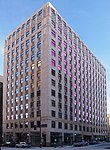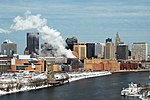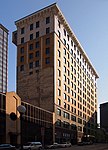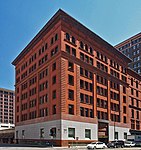Central station (Metro Transit)

Central (formerly known as 4th & Cedar until November 2011) is a light rail station along the Green Line in Saint Paul, Minnesota. It is unique among Central Corridor stations in that it is not located in the middle of or directly adjacent to a road, but rather at a 45° angle to surrounding streets like the U.S. Bank Stadium station on the Blue Line. It is located on the block bounded by 5th Street, Minnesota Street, 4th Street, and Cedar Street. Utility relocation construction work began along 4th Street in August 2009, well before the Green Line had received final funding or approval. Construction along Cedar Street, including demolition of the former Bremer Bank building on the block began in 2011. A skyway through the Bremer building was closed for much of the year but reopened on November 1, 2011. The station opened along with the rest of the line on June 14, 2014.
Excerpt from the Wikipedia article Central station (Metro Transit) (License: CC BY-SA 3.0, Authors, Images).Central station (Metro Transit)
Saint Paul Skyway, Saint Paul Downtown
Geographical coordinates (GPS) Address External links Nearby Places Show on map
Geographical coordinates (GPS)
| Latitude | Longitude |
|---|---|
| N 44.946144444444 ° | E -93.092188888889 ° |
Address
Central Station
Saint Paul Skyway
55146 Saint Paul, Downtown
Minnesota, United States
Open on Google Maps







